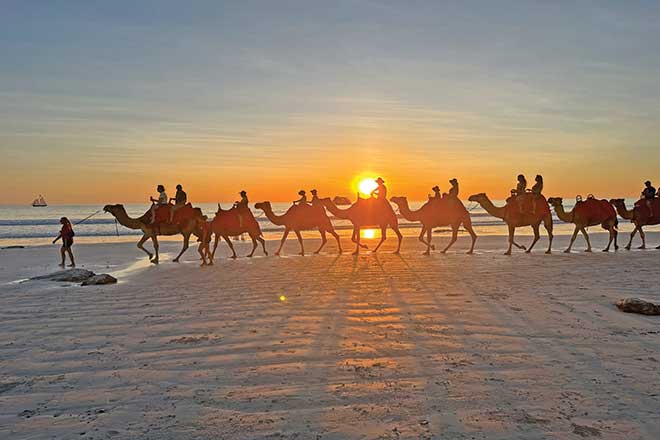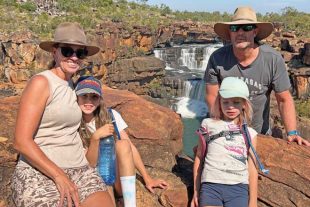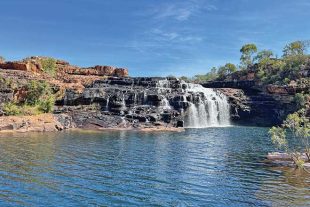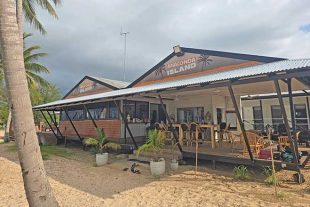Since mid-April my family – myself, wife and daughters five and seven-years old – has been travelling Australia.
We’ve spent several months making our way north along the Western Australian coastline, which has given me a new appreciation for how big our country is.
Following on from my previous article, after several days of exploring the stunning ancient landscapes and gorges of Karijini National Park, we headed back to the busy mining town of Port Hedland, with its huge bulk carriers.
The $187 million Spoilbank Marina project currently underway is impressive and will certainly see an increase in recreational fishos visiting the area once completed.
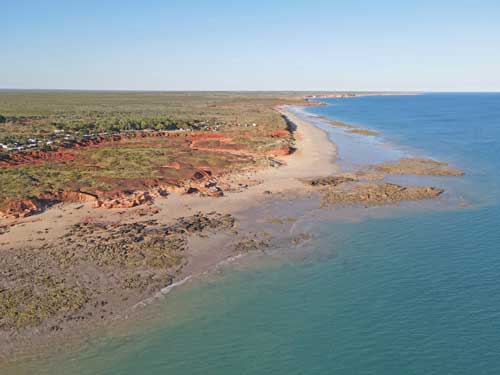
We checked the port out and stocked up on groceries, before heading further north to one of my favourite WA coastal camps yet – Cape Keraudren.
The impacts of category 5 Tropical Cyclone Ilsa – which hit the region in April – could still be seen in the flattened landscape and the completely destroyed Pardoo Roadhouse and Tavern.
Once we reach the campground, we found a great level spot overlooking the bay and kicked back with a campfire and cold beverage as the sun set over the water.
The next day, I caught a couple of small trevally off the rocks on a Halco Twisty Gold.
Noticing huge schools of garfish, I rigged the kids’ rods up and they had a ball catching garfish one after the other on bread squashed onto an unweighted Gamakatsu long shank size 12 hook.
The girls also managed a couple of very big bream, which put up a great fight on the light gear.
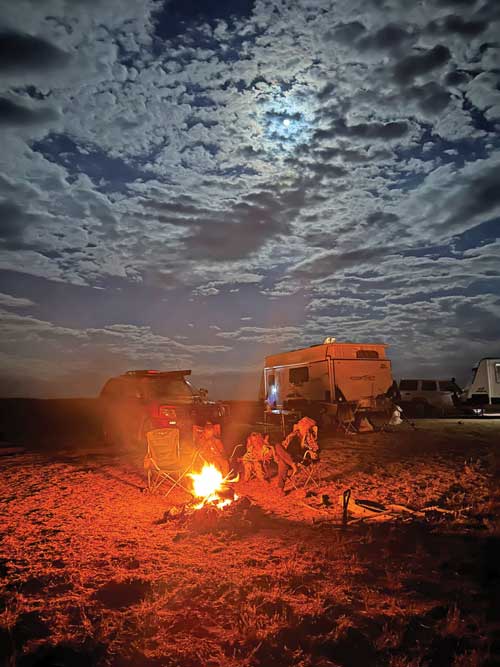
The tides were over 7m and at low tide the bay would completely drain, allowing keen mud crabbers to walk 1.5km to the other side in search of mud crab and octopus.
As some campers found out, it was a race to make it back before the tide started flooding again.
We caught up with some friends we’d met on the road.
They had already been at the campground for a couple of days.
Paul and his son Jack went for a dive off the headland and caught a couple of nice painted crayfish.
Which certainly had me keen to suit up and jump in because it would be one of the last places I’d have a chance prior to us heading further north into crocodile country.
We put a plan together and I joined Paul and Jack in the water.
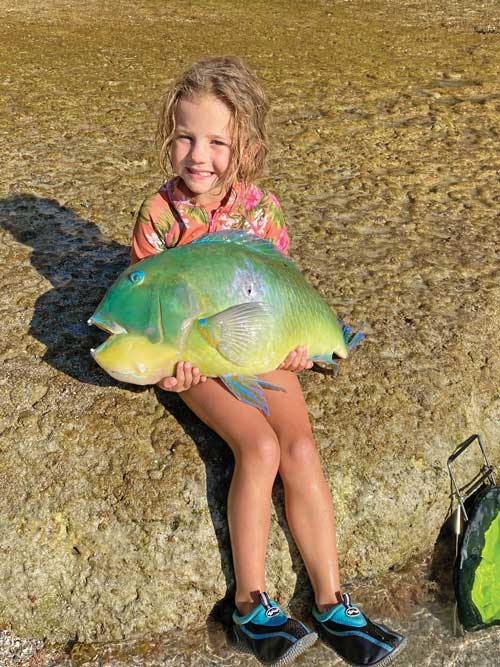
As any spearo knows, it is always safer to have dive buddies.
While the younger kids played in the rock pools, our wives kept a watchful eye on everyone.
The visibility was reasonable and there was plenty of fish life.
A few hours later, when the tide dropped, we would have to scale several metres back up the rocks.
I grabbed a quality painted cray and also speared a couple of nice mangrove jack that were filleted for dinner.
One of the best things about traveling the coast is actively hunting and fishing for fresh seafood.
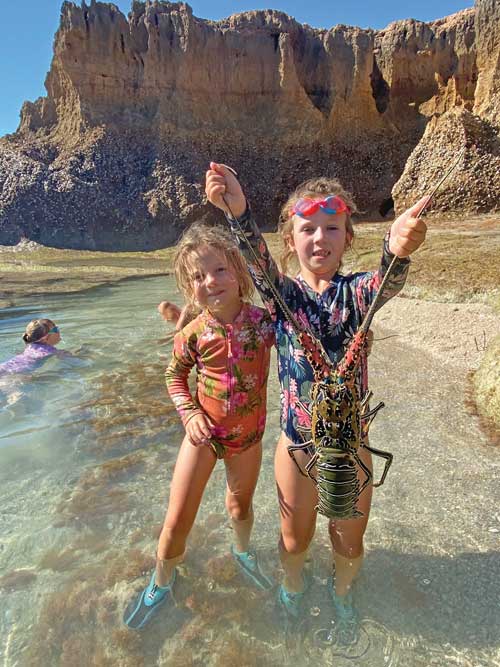
Paul also shot a monster blue bone that would have been over 8kg.
He had only recently taken up spearing and was elated – rightly so.
Towards the end of the dive, I thought I heard whales and those onshore confirmed later that two whales had passed only 30m behind where we were diving.
After a few days enjoying what Cape Keraudren had to offer, we packed up the van and continued 117km up the coast to Eighty Mile Beach, where we were booked into the caravan park.
Despite the name, the shoreline actually stretches 220km – or 137 miles – and is the largest uninterrupted beach in Western Australia.
Eighty Mile Beach is a shell collector’s paradise.
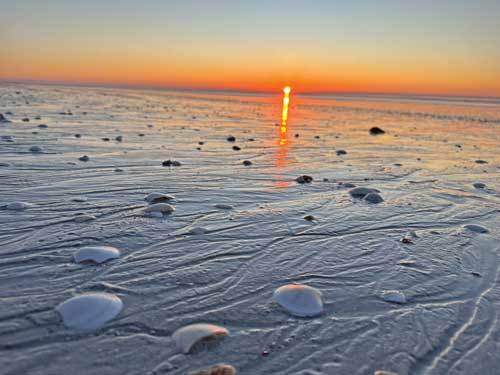
Dozens of people walk the beach early morning and late afternoon in search of little treasures, some staying in the park for several months to do just that.
Blue and threadfin salmon are regularly caught along the beach at high tide, along with blacktip reef sharks and the occasional black jewfish.
After chatting with a few travellers, not much had been caught and, without any obvious gutters or channels, it was a little guessing game as to where the fish were.
I went for a drive along the beach using the Navionics app to mark a couple of interesting areas to try at high tide.
As the tide goes out for almost 1km, there is only a two-hour window prior to the top of the tide that’s worth fishing.
I tried walking out to fish it earlier but found myself walking my gear up the beach every 10 minutes or so because the then 8.5m tide had water pushing over the sand flats very quickly.
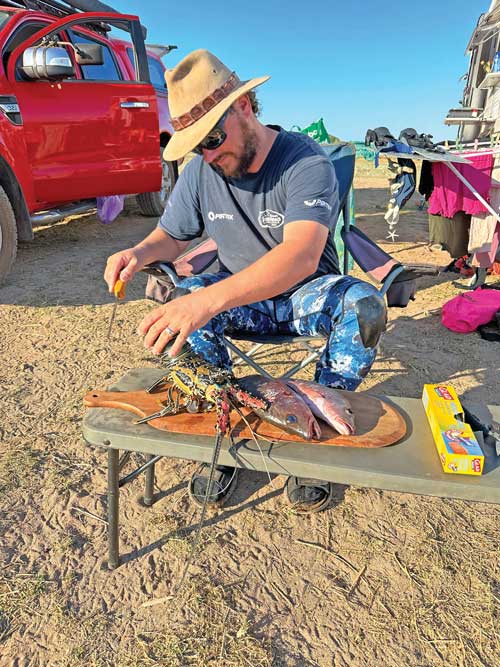
Prior to high tide, dozens of four-wheel-drives head onto the beach to stake their little patch of shoreline to fish – as the tide peaks, there is only a few metres of soft sand to park the car on before the base of the sand dunes.
I headed back to the area I’d marked on the Navionics app and walked a trail of berley up the beach to the car, the idea being that as the tide came in, more berley would be released into the water.
I fished with pilchard and strips of mullet but found I had fish picking up the bait and dropping it when they felt weight, so I used circle hooks with the Shimano Baitrunner OC 8000 and let them swim off with the bait before engaging the reel.
This resulted in a couple of nice blue salmon and a couple of blacktip reef sharks, which provided a bit of sport and were released.
The blue and threadfin salmon can be clearly identified by inspecting the filaments – or whiskers – with the blue salmon having four shorter filaments and the threadfin having five longer filaments and a more yellowish colouration.
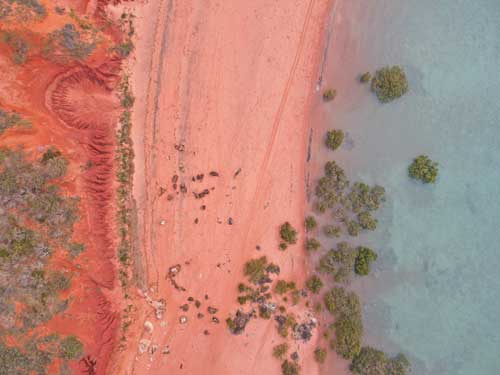
The king threadfin salmon grows much larger and is a more prized catch.
That said, blue salmon eats very well, so I filleted the fish and gave them to an elderly couple who had been spoiling my girls with figurines made from collected shells.
The next day, we met up with Paul and his family again and had another fish on the beach, and enjoyed the sunset over a few beverages while the kids found a few impressive shells.
Appreciatively, the caravan park has a wash-down bay and air for reinflating tyres – very convenient for campers.
Another 256km north of Eighty Mile Beach is Barn Hill Beach Side Station Stay.
This place is a family run cattle station situated on a breathtaking stretch of coastline, with the park well set up for travellers.
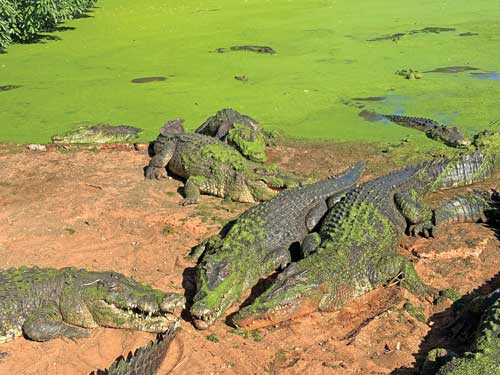
We’d booked an unpowered site overlooking the Indian Ocean and enjoyed more stunning sunsets in God’s country.
With live music, pizzas, a bowling green and taking a roofless shower under the Kimberley night sky, you couldn’t go wrong spending a few nights there.
The tides were then 9.5m and, faced with a stiff onshore breeze, I found land-based fishing quite tough.
This was blue bone country, so I set about targeting one of these brutes – initially by throwing around a crab imitation lure and then floating out prawns, which are both methods I’d had success with in the past – but this time, no such luck.
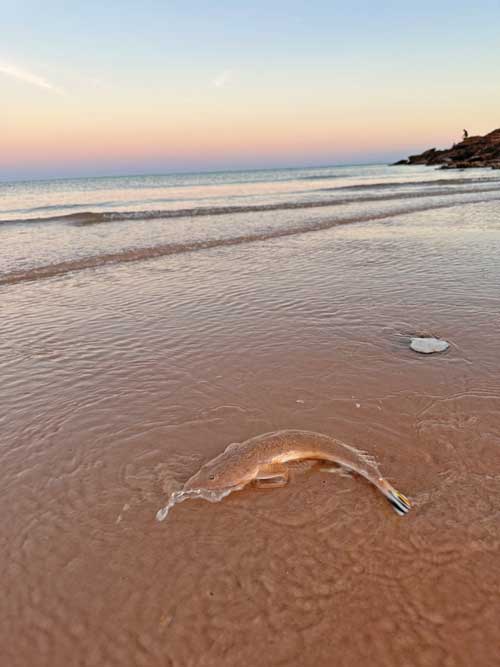
I flicked an assortment of plastics, hard-bodies and vibes and also tried some high-speed spinning for a queenfish or trevally with the ever-reliable Halco Twisty Gold but still came up empty handed.
Eventually, I downgraded to the kids’ rods and managed some garfish, whiting and a couple of very solid bream.
Unlike most areas along the coast that fish well on an incoming tide, Barn Hill seemed to fish better around the rocks as the tide started to recede.
After Barn Hill Station, it was a 140km drive to Broome, which had been a bucket-list location for some time.
We based ourselves at the Discovery Park for 10 days – a sensational spot overlooking the picturesque Roebuck Bay.
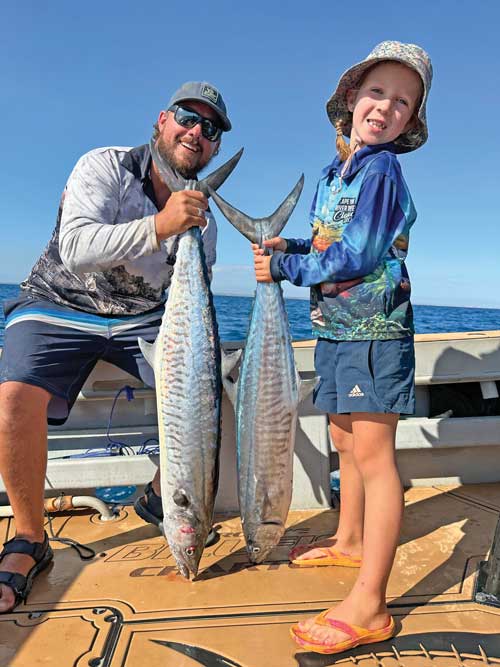
High tide was the time to admire the famous Kimberley colours of the red pindan cliffs, turquoise water, green mangroves and white sand.
We enjoyed the local sights and ticked off a few of the must-dos – such as camel rides on Cable Beach, night markets and Malcolm Douglas Crocodile Park.
The croc park was certainly an eye opener for the kids and a timely reminder to be croc-wise when heading further into croc country.
On the fishing front, I had a great session on queenfish in Roebuck Bay using a 30g Halco Twisty Gold.
Broome has several jetties that are worth a fish.
Town Beach Jetty is a great fishing platform but there’s usually a crowd.
While I didn’t fish there, we did see several trevally landed.
Streeter’s Jetty was originally built for pearl dealers and merchants – it is definitely worth having a flick around here for a salmon, barramundi or queenfish.
It’s also worth dropping the dillies in for mud crab – which I didn’t do but Paul did, and he landed a couple of monsters that I was a little envious of.
Finally, Deep Water Jetty at the Port of Broome is also worth a fish.
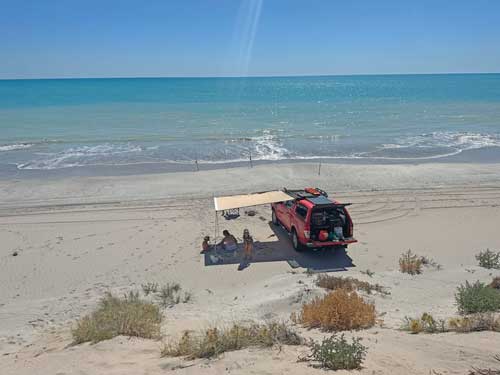
I spotted a couple of squid from the footbridge, so grabbed the rod and headed down to the beach as my wife Kristy reluctantly ‘guided’ me onto the squid – yelling out where to cast from above.
It worked a treat – I landed two squid in quick succession and dropped a third.
Not far from there are two boat ramps at Entrance Point, which give fishos a couple of launching options depending on the wind direction.
On the beach there, I had a fun couple of hours and managed seven bartail flathead on prawns as the sun was setting, which were all released.
The fun ended when what I suspect was a shark took both the bait and my rod – which I had foolishly leant against a bucket – and shot off into the water.
By then it was dark, so I flicked a spotlight about but wasn’t game to head out any further.
I was sad to say goodbye to my little Shimano Sienna combo that had accounted for many fish on this trip.
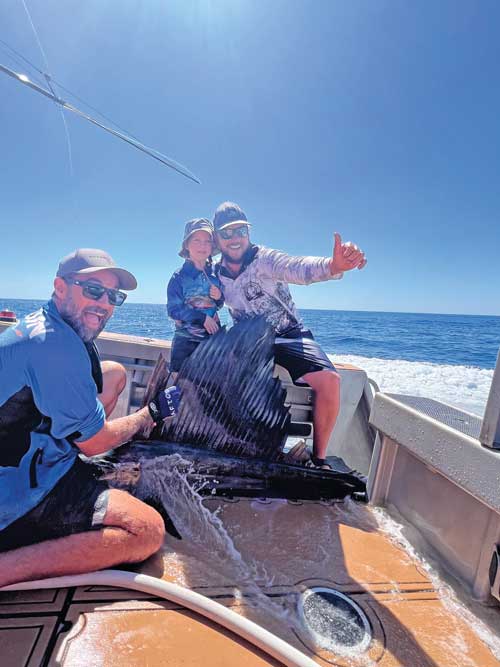
It was in Broome that I’d planned to go on a fishing charter – debating whether to chase barramundi or salmon, or perhaps head offshore to chase reefies.
I called around a few charter operators to make enquiries and with the forecast looking good, decided instead to chase sailfish with the crew at Broome Billfish Fishing Charters.
The Broome Billfish Classic had been held only a few weeks earlier, with the statistics going 383-271-194 and reports of plenty of sails and the occasional marlin still around.
So, we headed out, with my eldest daughter Zahlee also keen to get onboard the game boat Billistic.
The team run a fantastic operation – owner Ben, skipper Ash and deckhand Jack all know their stuff and fielded plenty of questions from myself and Zahlee.
It was about a 90-minute steam to the sailfish grounds and Jack kept everyone entertained, running through the rigs and game plan on the way out.
With teasers and daisy chains deployed, each of the four clients had a swimming garfish rigged on a circle hook.
When skipper Ash saw a sail come into the spread, he’d yell to the closest person to ‘dump’ their line – which meant to free spool it.
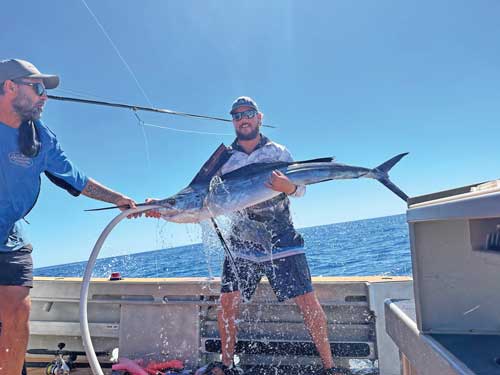
The hardest part was counting to five before engaging the reel – coming up tight, hopefully, as the circle hook did its job.
At about 90 minutes into trolling, not one but three sailfish were raised and, of course, it was the three other clients onboard who’d hooked up.
So, I cleared my line and stepped back to watch the mayhem unfold.
With reels screaming and sailfish tearing across the surface in all directions, things had gone from calm to chaos in a matter of seconds.
A critical error was made when one of the clients told the others they would get spooled if they didn’t tighten their drags, then reached over and locked up their Daiwa Saltiga reels – resulting in two of the three fish busting off.
Deckie Jack and I both called out “Leave it!”, but it was too late.
The crew did well to bite their tongues after working hard to find the fish.
Still, one sail was landed and, with bird activity increasing, it was a good sign.
We had a black marlin come into the spread a couple of times, but it failed to hook up.
Then it was my turn, so while everyone was having a bite to eat, I was sitting at my rod eagerly watching the teasers when the skipper yelled “Sailfish – dump it!”
I free spooled my gar and counted to five before engaging the reel.
I came up tight and was onto a nice sail that tore across the surface.
I played the fish back to the boat – it certainly put on a show.
Ash cut a couple of circles around the fish – a technique skippers use to try to keep sharks off the fish.
It was high fives all round – we landed a beautiful sailfish and took a couple of quick pictures while pumping water through the gills.
We quickly motored away from the sharks, swam the fish and watched it swim away healthy.
An hour later, several more sails were raised and another landed.
The final count on sails was 12-6-3, with a black marlin also coming into the spread.
With things going quiet, we finished off with a mad spanish mackerel session and, because the sharks were thick, we had only one line out taking turns.
The crew made Zahlee’s day by helping her land her first spanish.
Ash backed the boat up to each mackerel as if we had a 1000lb marlin on and Jack was swinging them aboard within 30 seconds of them being hooked.
It was a frantic session and a great way to top off the day, with no fish lost to the sharks circling below and a feed of fresh mackerel to take home.
The team at Broome Billfish Fishing Charters had certainly delivered, so if you’re heading to Broome, look them up.
In the next article, I’ll share more on our Kimberley adventure as we head across the notorious Gibb River Rd.
 Bush ‘n Beach Fishing Magazine Location reports & tips for fishing, boating, camping, kayaking, 4WDing in Queensland and Northern NSW
Bush ‘n Beach Fishing Magazine Location reports & tips for fishing, boating, camping, kayaking, 4WDing in Queensland and Northern NSW

